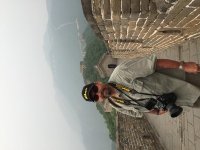thomasinaz
US Veteran
Late winter in Arizona is hiking time for me, so I head out to the hills looking for Indian ruins, and burning off some winter fat. I read about these "hill forts" several months ago and have been trying to climb up to as many as I can. These hill forts are a chain of ruins that are in sight of each other, and appear to have been built for defensive purposes. They're built on top of very steep sided hills and cliffs, with only one way to get to each of them. These don't contain any pottery shards or other indications of daily living, like in other more accessible ruins.
This photo is the object of my hike, from about 2/3 of the way up. On the top of the hill you can make out some walls, indicating the ruin.

This is the wall to the right of the entry.

This is inside the ruin, looking back toward the entry and the surrounding countryside.

This is more of the ruin from the back wall area looking toward the entry. To the left of the mountain in the background there's another one of these ruins, which I posted pictures of a couple of years ago. I didn't realize then that these other ruins were here and part of a series of hilltop ruins.

This is from outside the back wall. This wall was the most intact part of the ruin, and it's about 6 feet high on the outside and about 5 feet on the inside.

This is me resting against the back wall, happy to have finally made it up here.

This was my second attempt at this ruin. On the first attempt I came at it from the wrong direction and ran into some impassible cliffs. I can't imagine the effort it took to carry all these rocks up here, and build this structure. I can only speculate why they went to all this effort, defensive use and observation of the surrounding country are likely reasons.



This photo is the object of my hike, from about 2/3 of the way up. On the top of the hill you can make out some walls, indicating the ruin.

This is the wall to the right of the entry.

This is inside the ruin, looking back toward the entry and the surrounding countryside.

This is more of the ruin from the back wall area looking toward the entry. To the left of the mountain in the background there's another one of these ruins, which I posted pictures of a couple of years ago. I didn't realize then that these other ruins were here and part of a series of hilltop ruins.

This is from outside the back wall. This wall was the most intact part of the ruin, and it's about 6 feet high on the outside and about 5 feet on the inside.

This is me resting against the back wall, happy to have finally made it up here.

This was my second attempt at this ruin. On the first attempt I came at it from the wrong direction and ran into some impassible cliffs. I can't imagine the effort it took to carry all these rocks up here, and build this structure. I can only speculate why they went to all this effort, defensive use and observation of the surrounding country are likely reasons.



Last edited:

